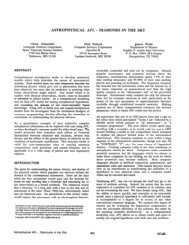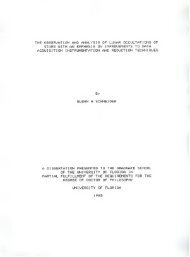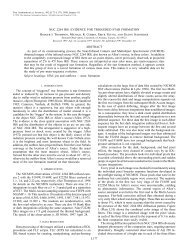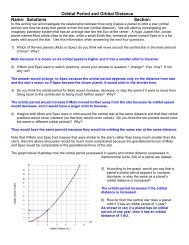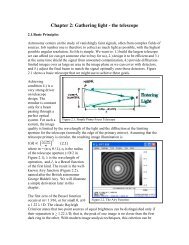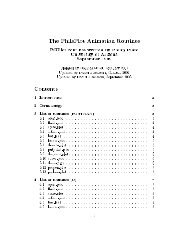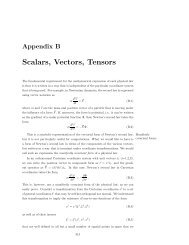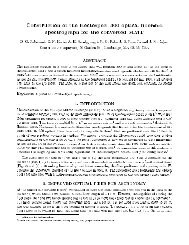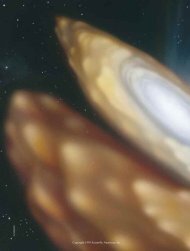James Muzerolle's Talk (pdf)
James Muzerolle's Talk (pdf)
James Muzerolle's Talk (pdf)
Create successful ePaper yourself
Turn your PDF publications into a flip-book with our unique Google optimized e-Paper software.
24 µm Data Reduction
24µm DAT mips_sloper<br />
Input: fits file with extensions<br />
each extension corresponds to a DCE<br />
# planes per extension: Nreads (RAW), 2 (SUR)<br />
units: DN/ read<br />
Corrections: applied to slope and/or first<br />
difference for SUR data<br />
Uncertainties from each correction added in<br />
quadrature, combined for final output frames
24µm DAT mips_sloper<br />
Order of processing:<br />
droop subtraction<br />
(rowdroop subtraction)<br />
dark subtraction<br />
linearization<br />
saturated slopes replaced by first difference
24µm DAT mips_sloper<br />
Output<br />
SUR: 7 planes<br />
1) corrected slope w/ replacements 5) uncertainty<br />
2) uncertainty 6) corrected 1 st<br />
difference<br />
3) data quality flag 7) uncertainty<br />
4) corrected slope<br />
units on all slope & uncertainty planes: DN/ sec
24µm DAT mips_sloper<br />
Output (cont.)<br />
data quality flags (* important only for RAW):<br />
1 = missing data 32 = noise spike*<br />
2 = auto. rejected read* 64 = cosmic ray*<br />
4 = bottom rail saturation, or 128 = no linearity correction<br />
possible SUR 1 st diff. saturation<br />
8 = upper rail saturation 256 = readout jump*<br />
16 = reset (Ge only)
24µm DAT mips_caler<br />
flat field division using calibration image
onorbit performance<br />
Formal uncertainties after corrections & flatfielding<br />
~ 1.5% for typical backgrounds<br />
Droop correction working properly: no shifts in<br />
background level apparent in maps (except where<br />
there is largescale saturation)<br />
Linearity correction confirmed: no evidence for<br />
change in calibration for bright standards
onorbit performance
onorbit performance<br />
effects discovered onorbit (primarily cosmetic!)<br />
backgrounddependent gradient from "read2" effect<br />
"dark latents" and jailbar pattern introduced by heavy<br />
saturation<br />
rowdroop effect does not appear<br />
dark spots which move with scan mirror
Read2 effect<br />
An offset in the second read<br />
causes SUR slope to be too<br />
large<br />
Depends on array position &<br />
background level<br />
For typical backgrounds, total<br />
gradient of ~1.5%<br />
Correction applied with analytic<br />
function subtracted from SUR<br />
slope values<br />
pixel in row 2<br />
row 60
Improved reductions<br />
mips_sloper t w (soon will be default)<br />
mips_caler +m F scan_dependent_flat<br />
for best results use same corrections for flat!!
Saturation issues<br />
Reduction in response in<br />
readout(s) exposed to<br />
extremely saturated source<br />
(>10 Jy) at about the 12%<br />
level<br />
usually reduced by<br />
redundancy; can<br />
sometimes be corrected by<br />
applying columndependent<br />
offset
Saturation issues<br />
Reduction in response at<br />
pixels exposed to extremely<br />
saturated sources (>10 Jy), at<br />
about the 12% level<br />
Dark latents can appear as a<br />
result of prior observations!!<br />
Removed by thermal anneal<br />
can be eliminated by dividing<br />
by a median of the data (e.g.,<br />
a scan leg)
Effects on calibration<br />
All detector/ illumination effects can be corrected to<br />
within ~ 2% for "typical" observations (not counting redundancy!)<br />
Saturation funnies affect a relatively small fraction of<br />
data, and can be corrected by hand in most instances<br />
distortion/ pixel size effects introduce a similar level of<br />
uncertainty in photometry (see Jane & Kate's<br />
presentations)<br />
Final calibration uncertainties probably dominated by<br />
systematics, such as differences in calibrator models (see<br />
Kate)
Improved scan maps
droop subtraction<br />
droop signal proportional to<br />
total signal on the array
owdroop subtraction<br />
rowdroop signal<br />
proportional to total signal<br />
on a given row (small!)<br />
(will be implemented in<br />
next DAT release)
dark subtraction<br />
subtract calibration image;<br />
counts are very small,<br />
~03 DN/ s<br />
typical 10s SUR dark
linearity correction<br />
data ramps<br />
parameterized by<br />
quadratic fit<br />
SURmode correction<br />
uses calibration image of<br />
ramp shape parameters




